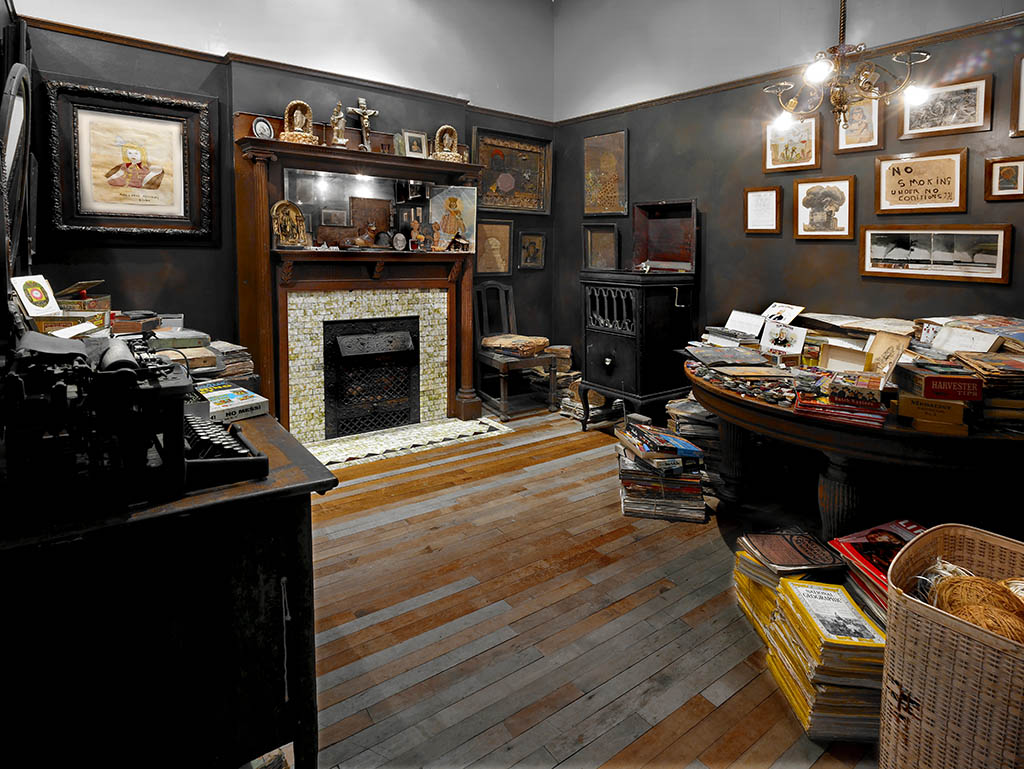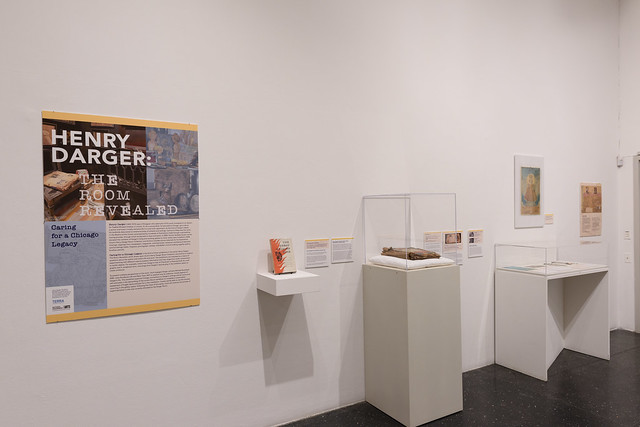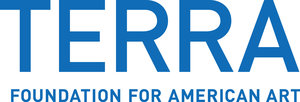
Henry Darger: The Room Revealed
Caring for a Chicago Legacy
Henry Darger (1892–1973) was a Chicagoan who spent part of his youth consigned to an Asylum for Feeble-Minded Children in Lincoln, Ill. As a young adult, he returned to Chicago, got a job as a janitor and lived a mostly-reclusive life in a one-room apartment. At the time of Darger’s death, his landlords discovered an extensive body of artwork and writings. Central to these was the novel, In the Realms of the Unreal, accompanied by hundreds of illustrations made through a painstaking tracing process, through which he learned to draw and paint. In 2000, former landlady Kiyoko Lerner donated the contents of Darger’s living and working spaces to Intuit, which were installed in 2008. The Henry Darger Room Collection and Archive includes source materials for his illustrations (tracings, clippings from newspapers, magazines, coloring books, cartoons); architectural elements and furnishings (table, fireplace, phonograph, dresser, chandelier); and art-making supplies (paints, brushes, pencils).
Caring for a Chicago Legacy is the third of three exhibitions in the series Henry Darger: The Room Revealed, which draws upon the Henry Darger Room Collection and Archive to explore questions about the author and artist’s life and work. The exhibitions are intended as a means of experimenting with different ways to present information and may range from audio components to tactile objects. For example, Darger’s Cast of Characters is featured both as a wall graphic and in scrapbook form, and songs from his records play in the exhibition space to create ambiance.
To present multiple perspectives on the work, Intuit engaged Darger scholars Michael Bonesteel, Leisa Rundquist and Mary Trent to explore how its collection reveals aspects of Darger’s life. The exhibition explores Chicago connections to Darger’s writing and art works and will culminate in the dismantling of the current Room exhibition to complete a conservation assessment of fragile items and plan for a new installation. Guests will be able to see this process occurring in the gallery space, beginning Tuesday, October 12. Following the close of this series, Intuit will continue the process of experimentation in the area currently allocated to the Darger Room.
Please note: Sunday, October 10, will be the last day guests see the Henry Darger Room intact until Intuit re-installs the exhibit.
Get a closer look
Take a virtual tour
Tour Caring for a Chicago Legacy from your device! To navigate the space, you can use the arrows on your keyboard or click the circles on the floor and drag your cursor to reposition. To read labels and see a work of art up close, click on the blue and teal pins; click the URL in the pop-up to open the file in another window.
Photos
View photos from Caring for a Chicago Legacy on Flickr.

Listen to Darger’s records
Found among the books, tracings and furnishings of Henry Darger’s one-room home studio were records. Tune in to a selection of songs from Darger’s collection along with compositions using Darger’s words, created, scored and produced by Philippe Cohen Solal with Mike Lindsay. Playlist cover photo © John Faier
In the exhibition, this playlist is accompanied by audio recordings of readings of Darger’s works by Geoffrey Carey. The songs from the album OUTSIDER and Carey’s recordings are courtesy of ¡Ya Basta! Records and Philippe Cohen Solal. Intuit thanks them for sharing these recordings. Learn more at www.outsideronline.co.
Press coverage
- Intuit to conserve contents of Henry Darger’s Room as part of “Caring for a Chicago Legacy”, Art Daily
Henry Darger: The Room Revealed is funded by the Terra Foundation for American Art and supported in part by an award from the National Endowment for the Arts.



